Princess, Ty Beanie Baby
Versions, Values & History
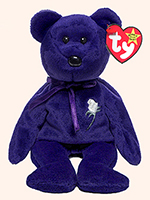
Current Princess Beanie Baby Values
Values updated - February 8, 2025
Note 1: Values shown in this table apply to a Princess in like-new condition with mint swing and tush tags. Princess without a swing tag (or a detached tag) is worth only one or two dollars for souvenir purposes.
Note 2: Inexperienced/amateur collectors are frequently confused by the Canadian customs tush tags and subsequently overpay for a Princess with this additional tush tag. The only Princess Beanie Babies recognized to be worth a higher value if they have the Canadian customs tush tags are the Indonesia, no-space swing tag, P.V.C. tush tag version or the Indonesia, no-space swing tag, P.E. tush tag version. Otherwise, the Canadian customs tush tag only adds one or two dollars to the normal value of any other version of Princess.
Note 3: Versions of Princess with an Indonesia "space" swing tag and P.V.C. tush tag have been available for bid or purchase on eBay from time to time. It is not known if this particular combination of tags was from an intentional production run or an oddity. In our opinion this is a no-space/P.V.C. Princess with a lost original "no-space" swing tag that was subsequently replaced with an incorrect "space" swing tag.
Current eBay fraud alert regarding Princess Beanie Baby "errors"
During the first six months of 2021, some sellers on eBay started alleging in their listings that their Princess Beanie Baby for sale had one or
more "errors" on its swing and/or tush tags. These errors are most commonly claimed to be "Oak Brook" spelled "Oakbrook," the "no-space" swing tag
itself; or odd spacing in the text. These are not unique or rare occurrences - this is the way Ty intentionally printed the tags for ALL of the
Princess Beanie Babies. Poem "space" and "no-space" tags represent different versions of the tag and are not errors. "Oak Brook" represented as
"Oakbrook" is normal on the millions of Princess Beanie Babies made by Ty, as well as countless other Ty plush product tags. The
inference of alleged "errors" on eBay listings of Princess is nothing more than a misinformed seller attempting to fabricate added
value where there is none. Since these are not legitimate "errors" from a collecting or rarity standpoint, they do not increase the value
of Princess or any other Beanie Baby.
Princess swing tags are often referred to by collectors as "space" or "no-space". This is a reference to the last four lines of text on the right inside of the swing tag. The no-space swing tag was attached to Princess bears produced in China during the first production period and also for some of the initial production in Indonesia. A "first edition" Princess MUST have the "no-space" swing tag attached.
Quick swing tag / tush tag references
"No-space" swing tag
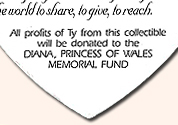
"Space" swing tag
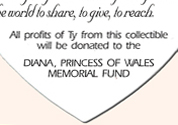
P.V.C. tush tag back (China)
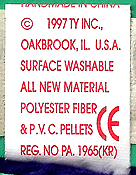
P.E. tush tag back (China)
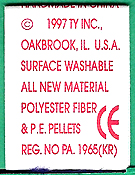
P.V.C. tush tag back (Indonesia)
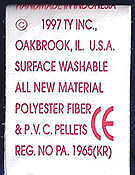
P.E. tush tag back (Indonesia)
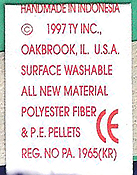
P.E. tush tag 2nd China period back
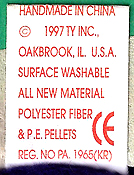
Tush tag (inside) Chinese factory number, 2nd China period
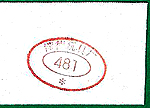
Canadian customs tag
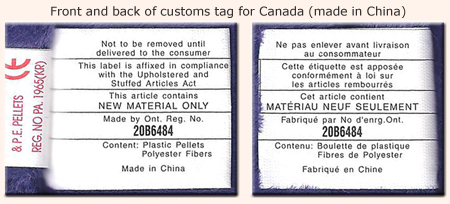
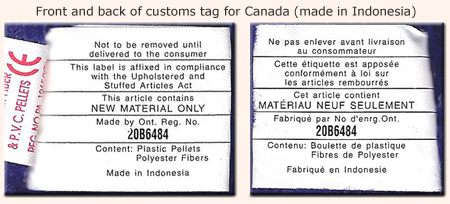
Princess versions and history

Princess introduction
Ty introduced Princess on October 29, 1997. In November 1997, Ty informed retailers they could only order 12 Princess Beanie Babies for delivery in December. This restriction caused many collectors and retailers to believe Princess would be a limited edition.
One example of the "limited edition" misinformation was the cover story editorial in the January 1998 edition of Collecting Figures magazine. The article inferred there was a "limited quantity" and even made the statement, "They should have made more if they're for charity."
The "limited edition" rumors caused a buying frenzy when Princess first shipped to Ty retailers in late December 1997. Announcements from Ty and Patricia A. Roche (Managing director of Ty Europe, at that time) that Princess would be in plentiful supply in 1998, did little to calm the buying frenzy.
Collector and speculator demand immediately drove the secondary market price for a Princess Beanie Baby to more than $200. Some retailers held back the Princess bears they received in the initial shipment, opting instead to auction them off or hoard them for future sale when values were anticipated to be higher. Various newspapers and magazines reported that collectors were buying Princess Beanie Babies on the secondary market for prices sometimes exceeding $300.
To this day, much of the production history for the Princess Beanie Baby is a mystery. Collectors who paid hundreds of dollars for Princess during the initial buying frenzy still believe Princess is worth more than the price they paid. Children who received Princess as a gift from their parents believe it is valuable today because "their parents told them so." New collectors are misled about Princess values by uninformed, dishonest or deluded sellers on eBay who frequently attempt to sell or auction Princess for prices ranging from hundreds to hundreds of thousands of dollars.
Ty never planned for Princess to be a limited edition Beanie Baby. He wanted to have Princess in stores before Christmas, but could not start producing them until he received approval from the Princess Diana Fund managers. Approval was granted on October 29, 1997, the same day Ty introduced Princess at the Ty Internet site. Once production began, time and logistics dictated the total number of Princess bears that could actually be produced and shipped to stores in time for Christmas. That was the only reason for the retailer limits of 12 Princess Beanie Babies in December 1997.
Searching for the facts
The very first shipments of Princess bears to arrive at retail outlets had a tush tag showing Princess was filled with P.V.C. pellets. In either late December 1997 or some time between January and March 1998 (existing accounts conflict with each other), Princess bears were discovered that had tush tags showing they were filled with P.E. pellets. The appearance of the P.E. pellet tush tags initiated a controversy that continues to this day. The controversy appears to focus on three questions:
1. Which version of Princess was produced first?
2. How many different versions of Princess did Ty produce?
3. How many Princess Beanie Babies of each version did Ty produce?
This article examines the Princess Beanie Baby timeline with a focus on existing evidence. Information about Princess in printed media and on the Internet has been copied, edited, recopied and creatively enhanced so many times it is difficult to separate speculation from truth. Ty does not release production and inventory records to the public, so there may always be a Princess mystery. Recollections of events by authorized Ty retailers who received the first shipments of Princess more than 27 years ago contradict each other.
It seems odd that a Beanie Baby with such a mediocre secondary market value today is so hotly debated by collectors. Princess Beanie Babies change hands frequently on eBay every month for less than ten dollars each. There is no shortage of eBay sellers claiming theirs is a "first edition" Princess even though many sellers are incorrect as evidenced by the photographs of Princess tags in their eBay listings. In recent years it has become a common practice for new sellers on eBay to copy existing eBay listings when they have something to sell. This practice introduces errors in the listings because in some cases, the new seller's items do not exactly match items in the existing listing they copied, and the seller has no clue there are different versions of swing and tush tags. It is a "buyer beware" environment.
Some sellers list Princess on eBay and other secondary markets with starting/asking prices ranging from thousands to sometimes hundreds of thousands of dollars. One can only hope potential buyers understand prices that high are not only unrealistic but essentially a joke. Most sellers on eBay claim their Princess is "rare," but the sheer number of Princess Beanie Babies available for sale on eBay refutes that claim. On February 8, 2025, when the Princess values were updated for this article, there were more than 8,500 Princess Beanie Babies listed for either sale or auction on eBay.
Ty plush collectors often strive to have the "first" version of any Beanie Baby. It is generally believed a "first" version will always be the most valuable. The surprise appearance of a P.E. tush tag on Princess caused dilemmas with collectors who were not sure which tush tag was the actual "first." Conflicting stories regarding the P.E. tush tag appeared in the media and on the Internet. Many collectors attempted to purchase two Princess bears, each with a different version of the tush tag. That way, one of the two bears had to be the "first edition."
Initially, the P.E. tush tag on Princess was presumed to be an error. A few articles in the media claimed Ty had announced the P.E. tush tag was a mistake and the Princess bears with P.E. tush tags were actually filled with P.V.C. pellets. Another media report claimed a Princess with the P.E. tush tag had been tested in a laboratory and found to be filled with P.V.C. pellets. We have not seen any documented copies of the alleged laboratory test results.
Conflicting theories and information
The initial presumption that the P.E. tush tag was a "mistake" created another rush to purchase Princess bears with the P.E. tush tag by collectors who specialized in Ty Beanie Baby "errors" or "oddities."
Then another theory surfaced claiming Ty had produced the Princess bears with the P.V.C. and P.E. tush tags simultaneously in two different Chinese factories. The theory held that a Princess with either of the tush tags could be considered a "first edition." There exists no publicly released documentary proof to substantiate the "two factory" theory. By "proof" I mean hard-copy Ty production records, stock inventories or other papers that would provide a Princess timeline detailing specifics of the first production run in China. The merchant who posted this two-factory theory on the Internet challenged anyone to "prove her wrong." That in itself is suspicious because she provided nothing credible to "prove herself right."
Since the first "two factory" theory appeared, other collectors have proposed different theories with the same challenge to "prove them wrong." Given the absence of any credible documentary evidence, none of these "prove me wrong" theories can be substantiated.
I have spoken with collectors who claim their version of the Princess history has to be true because they "heard" it from a Ty employee or even a Ty corporate executive. Those accounts should be discounted because they are never backed up by hard copy documents like a letter or email from the alleged Ty employee. These "Ty employee as the source of information" stories are even more unlikely considering Ty Warner's strict corporate rules that prohibit company employees from publicly disclosing any information about the company or the production of its products.
When all is said and done, the value of a Princess Beanie Baby bear (as with any other Ty collectible) is an average of the amounts willing buyers have paid to willing sellers in completed transactions over a three - six month period, with no incorrect or fabricated information about the items having been provided by the sellers.
First Princess production in China
A "first version" of Princess has the following swing tag. Note that the text on the right side of the swing tag does NOT have a line space above "DIANA, PRINCESS OF WALES". The left side of the tag states "Handmade in China". We refer to this swing tag as ST #1.
Made in China, original production period (ST #1)
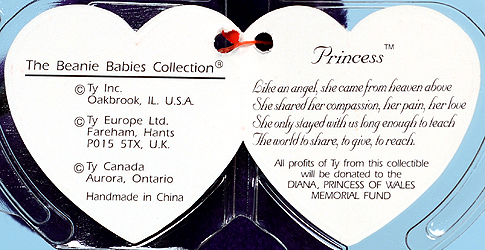
Princess swing tags are often referred to by collectors as "space" or "no-space". This is a reference to the last four lines of text on the right inside of the swing tag. The "no-space" swing tag was attached to Princess bears produced in China during the first production period and also for some of the production in Indonesia. A "first edition" Princess MUST have the "no-space" swing tag attached.
"No-space" swing tag

"Space" swing tag

The tush tag of a Princess with the "no-space" swing tag can show it is made from either P.V.C. or P.E. pellets. All of the Princess Beanie Babies sent to retailers in December 1997 were filled with P.V.C. pellets. That fact has been corroberated by professional authenticators from that time who fanatically followed and studied every Ty product release. In order for a Princess Beanie Baby to be a "first version," it must have a P.V.C. tush tag whether it is made in China or Indonesia.
Ty switched to P.E. pellets for all of his Beanie Babies during the period Princess was being produced. It is possible Ty had P.E. tush tags stockpiled in anticipation of the production change to P.E. pellets. Chinese factory workers may have accidentally (or even intentionally) used up the remaining P.V.C. pellets even though they had started using the new P.E. tags (until the supply of P.V.C. pellets was exhausted). That could explain the "theory" or "rumors" of the P.E. tags on Princess Beanie Babies filled with P.V.C. pellets. But there is no hard evidence for this scenario.
P.V.C. tush tag front (China)
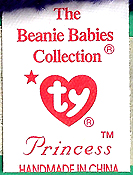
P.V.C. tush tag back (China)

P.E. tush tag front (China)
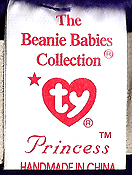
P.E. tush tag back (China)

Princess production in Indonesia
Princess was also produced in Indonesia. It appears that production in Indonesia started at the same time production began in China, but the exact dates for both are unknown.
Collectors frequently ask why an Indonesian Princess tends to be valued higher than a Princess from the first production period in China? The answer lies in the "mystique" surrounding all of the Beanie Babies produced in Indonesia, not just Princess. Indonesian Beanie Babies are reputed to have richer-colored and softer fabrics. Princess bears produced in Indonesia are much more difficult to find on the secondary market than Princess bears from the first period of production in China.
The Princess bears made in Indonesia were destined for the Canadian and European markets. This raises the possibility that Princess production in Indonesia began on the same date as production in China. If so, that would place the Princess bears made in Indonesia with no-space swing tags and P.V.C. tush tags into contention for "first edition" status.
The Princess bears made in Indonesia can have a ST #2 (same as ST #1, except that "Handmade in Indonesia" is printed on the inside bottom left of tag) or the follow-on ST #3. Note that the text on the right side of ST #3 has a line space above "DIANA, PRINCESS OF WALES".
Made in Indonesia (ST #2)
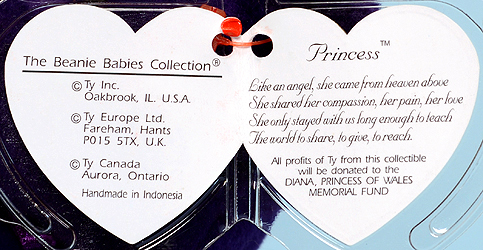 v
vMade in Indonesia (ST #3)
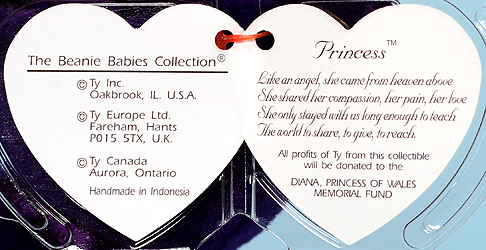
The tush tag of a Princess produced in Indonesia can show it is filled with either P.V.C. or P.E. pellets. P.V.C. and P.E. tush tags were paired with the Indonesian Princess with ST #2 (no-space). P.E. tush tags were paired with ST #3 (space). Although a few have been reported, it is not currently known whether the ST #3 (space) with a P.V.C. tush tag was a normal production run, an oddity or an intentional tag replacement. That tag combination does not logically fit the tag combination timelines. We have seen this version for sale on eBay from time to time. In my opinion, this is a no-space/P.V.C. Princess with a lost original swing tag that was subsequently replaced with an incorrect (space) swing tag by resellers.
P.V.C. tush tag front (Indonesia)
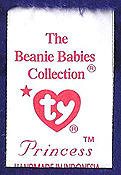
P.V.C. tush tag back (Indonesia)

P.E. tush tag front (Indonesia)
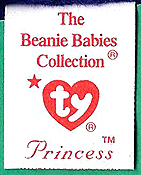
P.E. tush tag back (Indonesia)

Ty discontinued production of Princess in Indonesia because of problems with quality. Production was shifted 100 percent to Chinese facilities. A shift of production like this from one country to another raises obvious questions. Answers to these questions could have a definite bearing on Princess versions and values. Given the absence of credible information or release of official documents from Ty however, these questions may never be answered.
1. Did production in China and Indonesia begin simultaneously?
2. When Ty stopped production in Indonesia, were unused fabrics, pellets and tags transferred to the Chinese factories?
3. Was there any timeline break in production at the Chinese facilities?
4. How many separate/individual Chinese factories were actually producing Princess Beanie Babies?
5. At what point/date in the Princess timeline did Ty begin placing the Chinese factory stamps inside the Princess tush tags?
6. How many Princess bears were actually made during the first production period in China, the production period in Indonesia, and the production period in China after production in Indonesia was halted?
Post-Indonesia Princess production in China
The Princess bears made in China after production stopped in Indonesia may or may not have a Chinese factory stamp inside the tush tag. The tush tags with factory number stamps inside are the last production runs and worth the least of all the swing tag/tush tag combinations. Princess bears made during this period had a new version of the swing tag that shows "Handmade in China", and a line space above "DIANA, PRINCESS OF WALES" (ST #4).
Made during second production period in China (ST #4)
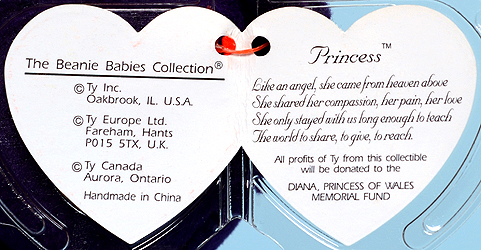 v
v Second production period in China (ST #4a)
"Gosport" misspelled "Gasport" on left inside of swing tag
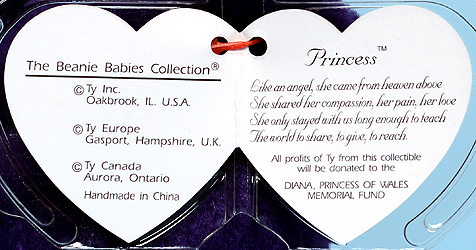
The Princess bears made during the second period of production in China have tush tags like the one shown below. Most (not all) of the tush tags from this production period have a red stamp inside the loop of the tush tag that represents the Chinese factory of origin. It isn't known how many different numbered stamps there are for Princess. We can confirm the existence of numbers 400, 401, 403, 405, 410, 416, 418, 425, 433, 445, 447, 450, 463, 464, 466, 472, 474 and 481. Number 487 has been reported but we can not confirm that one. When you look at the tag below with the number 481 inside the circular stamp, it is easy to see why the last number might be interpreted to be a "7" instead of a "1."
Note: Princess is not the only Beanie Baby produced with Chinese factory stamps inside the tush tags. Several other Beanie Babies produced during that period also have the same types of stamps with various numbers inside their tush tags.
P.E. tush tag 2nd China period front
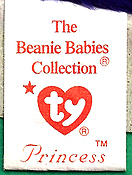
P.E. tush tag 2nd China period back

Tush tag (inside) Chinese factory number, 2nd China period

Prices paid on eBay for Princess bears from the second period of production in China with factory marks in the tush tags fluctuate erratically. The actual value of Princess bears from this period (with red factory markings inside the tush tags) is the lowest of all the swing tag/tush tag combinations, but novice purchasers become confused by the Chinese factory markings; erroneously believing the number denotes a limited or special production run. Some sellers take advantage of this confusion by placing extra emphasis on the "number."
Many sellers also attempt to draw attention to their listing by stating the tush tag on their Princess has the red star next to the heart. That is hardly consequential since ALL of the Princess Beanie Baby bears have the same red star.
Canada customs tags
Canada has regulations that require a special tag be attached to plush products imported from other countries. Referred to by most Ty collectors as "extra Canadian tush tags," these tags were attached to Princess bears produced in Indonesia and then in China during the second production period. Princess Beanie Babies with these tags were destined to be sold by retailers in Canada. The Princess Beanie Babies produced in Indonesia with the "no-space" swing tag, a P.V.C. tush tag and the Canadian customs tag normally show sales at higher values on eBay than any of the other Princess versions. For any of the other versions of Princess, the Canada tush tag adds only one or two dollars to the value of the Beanie Baby.


Fraud Alert (April 18, 2015) - Daily Mail, UK and The Sun, UK
In a newspaper article on April 18, 2015, the UK Daily Mail and The Sun (UK) provided misleading information about Princess Beanie Baby values. Once again, tycollector.com was inundated with emails from people in the UK and Ireland hopeful that their Princess Beanie Baby was worth a lot of money and asking about the best way to sell theirs.
The writer of the original article (as is usual with many "Ty collectible values" types of articles) used "listing" prices on eBay, as opposed to the prices buyers have actually paid for Princess over the past 90 - 180 days, to support the premise that Princess is valuable.
We are truly sad so many peoples' hopes were mistakenly raised by reading a fraudulent article that suggested they might own a rare and valuable Princess Beanie Baby. We feel even worse about amateur speculators who were tricked or motivated by the incorrect articles to pay atrociously high prices for Princess on eBay for the weeks following the publication of the misleading articles. Prices being paid for Princess on eBay rose across the board for almost all versions due to the incorrect newspaper articles. The number of Princess Beanie Babies listed on eBay also rose by more than 40 percent after the articles were published, once again demonstrating that Princess is not "rare."
Previous surges in Princess values based on incorrect media releases normally lasted from one to three months, after which values declined 30 - 50 percent. That same cycle appears to be repeated any time a "Princess is valuable" article appears in the media.
Fraud Alert (January 14, 2015)
From time to time, prices paid by buyers on eBay for the Princess Beanie Baby increase dramatically for a short period of time. This generally happens when a blogger, a personality on a TV show or a news reporter claims Princess is valuable because it is selling for an extremely high price on eBay.
That of course, is an uninformed misrepresentation or sometimes an intentional deception designed to scam potential collectors who do not understand how eBay really works.
Here is an example.
Joe Gotcha has a crisp new one dollar bill. He creates an eBay auction listing for his dollar, with a $300,000 starting bid. Or, he lists it as a "buy it now" item for $300,000, or "best offer."
There is no eBay policy that prohibits Joe from asking for any price he wants. He even lists the serial number of the one dollar bill and claims in the listing it is a one of a kind item. He's not really lying; there is only one dollar bill in existence with that serial number.
Then Joe goes to his blog on the Internet and informs the world that the value of one dollar bills has risen out of sight because some unique bills are now selling on eBay for $300,000.
Do you think anyone will bid on that one dollar bill? Of course not. But believe it or not, there are desperate speculators out there who might very well purchase some other one dollar bills at eBay for $50 or $75, just in case the "rumors" are true. And naturally, Joe has listed those too (at the lower prices) in order to snag a few buyers who think they are getting a good deal.
That is exactly what happened in early January 2014 with Princess. An online news reporter suggested Princess could be worth $300,000 because that was the price it was selling for at eBay. Tycollector was suddenly inundated with emails from Princess owners who wanted to know if it was true and also where they could sell the Princess they owned. "Hope springs eternal."
Unfortunately, and quite sadly, several inexperienced collectors and/or speculators bought Princess Beanie Babies on eBay in January 2014 for prices well in excess of the bear's worth, apparently after reading or hearing about the news reporter's incorrect value claims.
When we see spikes in the value of Princess Beanie Babies due to events like this, we do not use the outrageously high prices paid for Princess at eBay in our value computations for at least a 60-day period. By then the secondary market has settled sufficiently to resume using all of the prices paid at eBay in our value formulas. During these temporary periods of artificial value hype we focus more on the prices being charged and received by known "honest" collectors and dealers.
The same thing happened in 2013 when an uninformed "appraiser" on a popular television show suggested a Princess Beanie found in an abandoned storage room could be worth hundreds of thousands of dollars depending on which version of Princess it happened to be. That incorrect assessment was also based on what Princess was being "listed" for on eBay instead of the true indicator; the prices buyers actually "PAY" for Princess in completed transactions on eBay.
Buyers beware. We would gladly and immediately notify collectors if something transpired that would cause a dramatic increase in the value of a Princess Beanie Baby. It would of course have to be something like a P.V.C.-eating virus that is destroying all of the Princess Beanies in the world that were not protected in sealed plastic containers; but short of something remarkable like that, it isn't likely the true value of the Princess Beanie Babies will be skyrocketing any time soon - or in our lifetimes for that matter.
More information on the way
Collectors generally acknowledge that the Chinese and Indonesian versions of Princess are slightly different because of the different Indonesian-made fabrics used in production. A few collectors claim they have discovered additional differences in Princess fabrics, embroidery, and color that suggest there are even more versions of Princess than previously believed. Princess also exists in various sizes (heights) from 7.75 inches to 9.25 inches. To date, we have not seen a credible and consistent difference that would relate the various sizes or tints of the purple fabric to the production timeline or country of manufacture. Speculators conveniently forget that Beanie Babies are hand-sewn by large groups of factory workers. That is the explanation for size and other minor style differences in Princess and all other Beanie Babies as well.
Differences in shades of Princess fabrics are likely due to minor variations in color consistency due to the dying process used on the fabrics. Color variations can also be created based on the conditions under which Princess is displayed or stored after purchase.
Counterfeit Alert !
Counterfeit versions of Princess exist. Check for the following common indicators before purchasing this Beanie Baby:
1. The counterfeit Princess has a "made in China" no-space swing tag and a P.V.C. tush tag.
2. The fabric on a counterfeit Princess can be lighter or darker than the fabric on an authentic Princess, which makes it difficult to identify a counterfeit solely based on fabric color.
3. The fabric on many counterfeit Princess Beanie Babies looks more like flannel than the normal plush fabric used for Beanie Babies.
4. When you run your finger against the nap of the fabric on a counterfeit Princess, it feels rougher than the fabric of an authentic Beanie Baby. When brushing lightly back and forth across the fabric of an authentic Beanie Baby the fabric is smooth and gives little resistance.
5. The neck ribbon of a counterfeit Princess is well made but only finished on one side. The other side is dull. The ribbon on an authentic Princess is finished on both sides. The ribbon on some counterfeit Princess Beanies is also slightly wider than the ribbon an an authentic Princess.
6. The stem of the rose embroidered on the chest of a counterfeit Princess may be slightly wider and fuller than the stem of the rose on an authentic Princess.
7. The swing tag on a counterfeit Princess can have several flaws including uneven width of the gold border around the tag, incorrect red color and incorrect or off-center spacing of the writing inside the yellow star.
Note: It is possible for a Princess itself to be authentic but to have a counterfeit/replacement ribbon and/or counterfeit swing tag. Since the value of a Beanie Baby decreases so markedly when it has no swing tag, counterfeiters have been known to acquire authentic Princess Beanie Babies without their swing tags and/or ribbons and then add the counterfeit ribbons and tags to bring the value back up.
Caution about eBay Sellers !
We have noticed some eBay sellers estimating Princess values in their eBay listings. In most cases, there is absolutely no credible basis for these value estimates. If you (as a potential buyer) are sufficiently naive to believe sellers will HONESTLY estimate values on items they themselves are selling, you should not be purchasing collectibles on eBay. Seller estimates of value are a blatant conflict of interest. We have also seen that these (personal opinion) estimates tend to be highly inflated.
The values we provide semiannually for Princess are based solely on recorded and legitimate current sales. We can be honest and impartial with value calculations because we do not buy and sell Princess Beanie Babies. We have absolutely no vested interest in the value of Princess and provide the valuations as a service to collectors who need unbiased and credible information on which to base potential purchases. We do not provide this value service for any other Beanie Babies. That allows us to focus solely on the Princess values.
eBay Prices & tycollector.com Valuation
The process for determining the approximate value of any Ty collectible is now based on a periodic average of the amount willing buyers actually pay willing sellers for the item. Printed value guides are a thing of the past because values change almost every day, due primarily to the new online secondary markets like eBay.
To determine the values for Princess, we take all of the available "sold listings" values (completed transactions) for each verifiable category of Princess during the previous 30-90 day period and average those prices paid.
From time to time, an eBay sale is registered at an unusually high price so far out of the normal range for a particular variety of Princess, it is totally uncharacteristic and in our opinion should not be used to determine average values. An example would be a Princess that sells for $500, when several sold for under $50 in the days preceding the high value sale, and then several more sold for under $50 in the days following the high value sale.
We also tend to omit sales at uncharacteristically high values when the seller has misrepresented the facts or otherwise attempted to manipulate the listing in order to make their Princess appear more valuable than the secondary market averages for that item.
References:
beaniemom.com (discontinued in 2004)
Beanie Collector magazine, Spring 1998, Trend Masters Publications
Ongoing "Completed (sold) listings" for Princess Beanie Babies at eBay.com
Swing tag, tush tag and Princess Beanie Baby photos provided by Leon and Sondra Schlossberg, curators of the tycollector.com Ty Museum collection.

